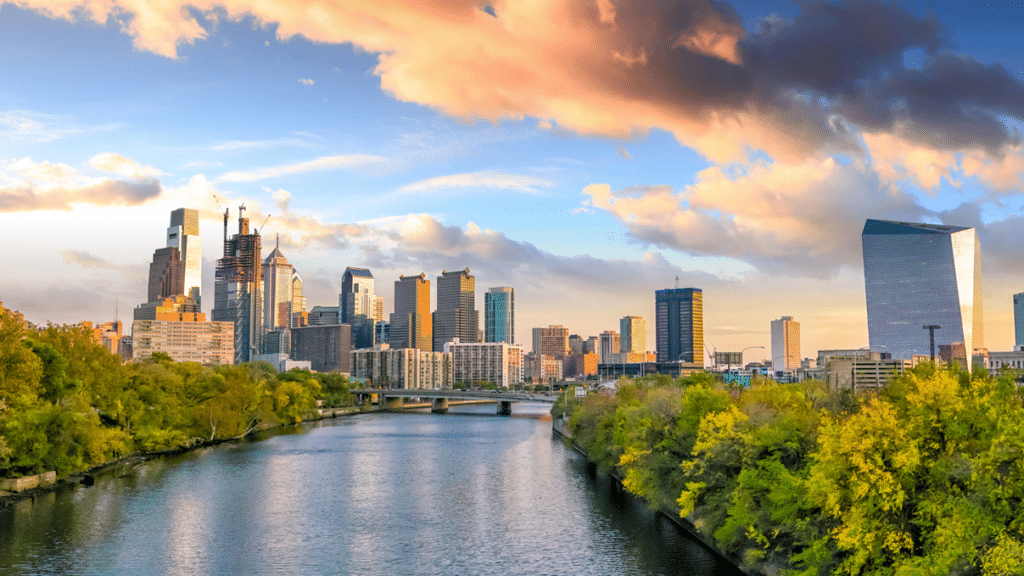

Urban planning is the cornerstone of creating vibrant, sustainable, and livable communities. In the bustling corridors of Southeastern Pennsylvania and New Jersey, the importance of thoughtful urban development cannot be overstated.
From managing population growth to addressing transportation challenges, urban planning plays a pivotal role in shaping the future of our cities and towns.
What’s the Current State of Urban Development in PA & NJ?

Urban development in Pennsylvania and New Jersey reflects diverse trends shaped by population density, economic activity, and historical legacies.
Here are some of the most relevant urban trends in these states:
- Mixed-Use Development: Increasing integration of residential, commercial, and recreational spaces.
- Transit-Oriented Development: Emphasis on developing communities around public transportation hubs.
- Adaptive Reuse: Conversion of historic buildings and industrial sites into residential lofts, offices, and cultural centers. Lancaster has become a great example of this since historical architecture has been integrated with contemporary urbanism according to Harrisburg Regional Chamber & CREDC, 2014.
- Smart Growth: Concentration of development in existing urban areas to minimize sprawl and preserve open space.
- Green Building Practices: Incorporation of sustainable design principles, such as LEED certification and energy-efficient construction.
- Affordable Housing Initiatives: Efforts to address housing affordability through inclusionary zoning and affordable housing developments.
- Revitalization of Urban Centers: Renewed focus on downtown areas to attract businesses, residents, and visitors. For example, downtown redevelopment is making Allentown one of the top cities in Pennsylvania.
- Brownfield Redevelopment: Rehabilitation of contaminated sites for residential, commercial, or recreational use.
- Complete Streets: Designing streets to accommodate pedestrians, cyclists, and public transit alongside cars.
- Placemaking: Creating vibrant public spaces that encourage community interaction and engagement.
Both states grapple with challenges such as aging infrastructure, transportation congestion, and revitalizing industrial areas.
Current Urban Development Challenges in Pennsylvania and New Jersey:
Pennsylvania:
- Population Decline in Rust Belt Cities: Cities like Scranton, Erie, and Reading face challenges associated with declining populations, including vacant properties, diminished tax bases, and reduced economic opportunities.
- Aging Infrastructure: Pennsylvania’s aging infrastructure, including roads, bridges, and water systems, requires significant investment for maintenance and modernization.
- Urban Sprawl: The expansion of suburban development into rural areas leads to fragmented communities, increased traffic congestion, and loss of open space.
- Brownfield Redevelopment: The remediation and redevelopment of contaminated sites, known as brownfields, pose challenges due to potential environmental hazards and financial constraints.
- Affordable Housing Shortage: Urban areas, particularly in the southeast, face challenges in providing affordable housing options for low- and middle-income residents.
New Jersey:
- High Cost of Living: New Jersey’s high cost of living, including housing costs and property taxes, poses challenges for residents and businesses, impacting affordability and economic competitiveness.
- Transportation Congestion: Traffic congestion, especially in northern New Jersey, leads to delays, increased commute times, and air pollution, impacting quality of life and economic productivity.
- Coastal Flooding and Sea Level Rise: Coastal communities like Atlantic City and Hoboken face threats from flooding and sea level rise, requiring adaptive measures to protect infrastructure and residents.
- Property Tax Burden: New Jersey’s reliance on property taxes to fund local services creates disparities between municipalities and challenges for municipalities with limited tax bases.
- Gentrification and Displacement: Urban revitalization efforts in cities like Jersey City and Newark can lead to gentrification and displacement of longtime residents, exacerbating housing affordability issues.
Addressing these challenges requires coordinated efforts from government, community organizations, and private stakeholders to promote sustainable and equitable urban development in Pennsylvania and New Jersey.
What is Sustainable Urban Planning?

Sustainable urban planning emphasizes environmentally conscious and socially equitable development practices.
By prioritizing factors like energy efficiency, green spaces, and public transportation, sustainable urban planning aims to create communities that thrive while minimizing environmental impact.
Innovative Urban Planning Projects in Southeastern Pennsylvania & NJ
In Southeastern Pennsylvania, initiatives like the revitalization of urban centers in Bethlehem and Reading demonstrate the transformative power of strategic planning and community engagement.
Another good example is Lafayette Street Corridor Extension Project that intends to “directly connect Norristown to the highway network, making it quicker and easier for people to enter the downtown and Schuykill riverfront” as described by the Norristown Economic Development website.
In New Jersey, initiatives like the redevelopment of Camden’s waterfront and Newark’s transit-oriented development showcase efforts to create more sustainable, walkable communities.

Community Involvement and Public Policy
Community involvement is vital in urban planning processes, ensuring that the voices and needs of residents are heard and incorporated into development plans.
Policies that encourage public participation and prioritize sustainability are crucial for fostering inclusive and resilient communities.
Therefore, both community involvement and public policy are essential. This is why The Department of Community and Economic Development of Pennsylvania “Consultation and Citizen Participation” in The Consolidated Plan for Housing and Community Development.
The Future of Urban Planning in PA and NJ
The future of urban planning in Pennsylvania and New Jersey is marked by innovation and adaptation.
Predictions suggest increased emphasis on mixed-use developments, smart transportation solutions, and sustainable building practices.
A good example is the Sewage Free initiative that works with NJ community and statewide organizations to advocate for solutions to sewage overflows into rivers and dirty wastewater flooding into streets and homes.
Technology will play a significant role, with advancements in data analytics, renewable energy, and smart infrastructure shaping the urban landscape.
Urban Planning Takes A Village!
Urban planning holds immense potential to transform Southeastern Pennsylvania and New Jersey into more sustainable and livable areas. By embracing innovation, community engagement, and sound public policy, we can create cities and towns that thrive for generations to come.
At Carroll Engineering Corporation, we as civil engineers are prepared to work together with policymakers and community leaders to support urban planning initiatives and build the vibrant and resilient communities of tomorrow. Together, we can shape a brighter future for all.
